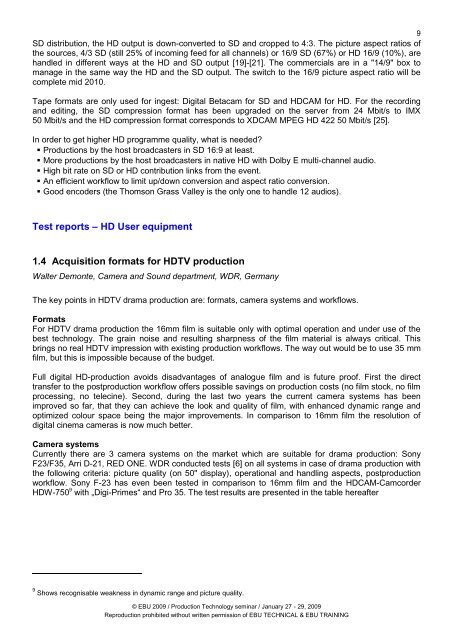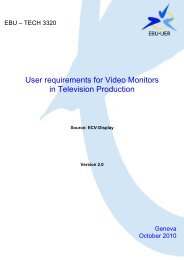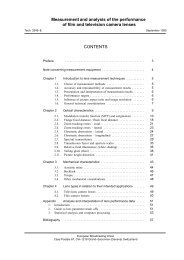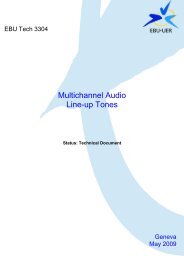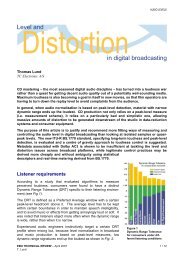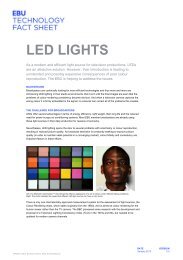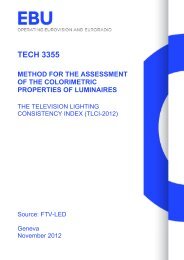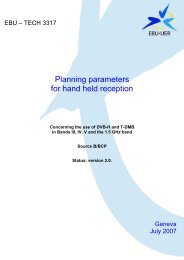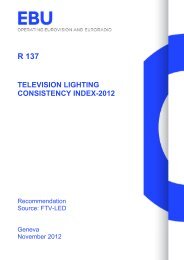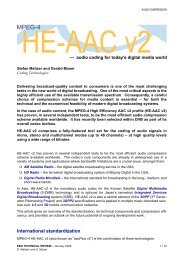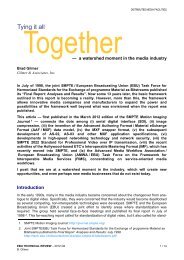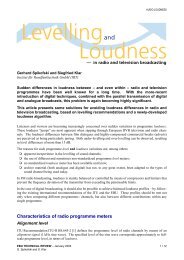Production Technology Seminar 2009 - EBU Technical
Production Technology Seminar 2009 - EBU Technical
Production Technology Seminar 2009 - EBU Technical
Create successful ePaper yourself
Turn your PDF publications into a flip-book with our unique Google optimized e-Paper software.
9<br />
SD distribution, the HD output is down-converted to SD and cropped to 4:3. The picture aspect ratios of<br />
the sources, 4/3 SD (still 25% of incoming feed for all channels) or 16/9 SD (67%) or HD 16/9 (10%), are<br />
handled in different ways at the HD and SD output [19]-[21]. The commercials are in a "14/9" box to<br />
manage in the same way the HD and the SD output. The switch to the 16/9 picture aspect ratio will be<br />
complete mid 2010.<br />
Tape formats are only used for ingest: Digital Betacam for SD and HDCAM for HD. For the recording<br />
and editing, the SD compression format has been upgraded on the server from 24 Mbit/s to IMX<br />
50 Mbit/s and the HD compression format corresponds to XDCAM MPEG HD 422 50 Mbit/s [25].<br />
In order to get higher HD programme quality, what is needed?<br />
� <strong>Production</strong>s by the host broadcasters in SD 16:9 at least.<br />
� More productions by the host broadcasters in native HD with Dolby E multi-channel audio.<br />
� High bit rate on SD or HD contribution links from the event.<br />
� An efficient workflow to limit up/down conversion and aspect ratio conversion.<br />
� Good encoders (the Thomson Grass Valley is the only one to handle 12 audios).<br />
Test reports – HD User equipment<br />
1.4 Acquisition formats for HDTV production<br />
Walter Demonte, Camera and Sound department, WDR, Germany<br />
The key points in HDTV drama production are: formats, camera systems and workflows.<br />
Formats<br />
For HDTV drama production the 16mm film is suitable only with optimal operation and under use of the<br />
best technology. The grain noise and resulting sharpness of the film material is always critical. This<br />
brings no real HDTV impression with existing production workflows. The way out would be to use 35 mm<br />
film, but this is impossible because of the budget.<br />
Full digital HD-production avoids disadvantages of analogue film and is future proof. First the direct<br />
transfer to the postproduction workflow offers possible savings on production costs (no film stock, no film<br />
processing, no telecine). Second, during the last two years the current camera systems has been<br />
improved so far, that they can achieve the look and quality of film, with enhanced dynamic range and<br />
optimized colour space being the major improvements. In comparison to 16mm film the resolution of<br />
digital cinema cameras is now much better.<br />
Camera systems<br />
Currently there are 3 camera systems on the market which are suitable for drama production: Sony<br />
F23/F35, Arri D-21, RED ONE. WDR conducted tests [6] on all systems in case of drama production with<br />
the following criteria: picture quality (on 50" display), operational and handling aspects, postproduction<br />
workflow. Sony F-23 has even been tested in comparison to 16mm film and the HDCAM-Camcorder<br />
HDW-750 9 with „Digi-Primes“ and Pro 35. The test results are presented in the table hereafter<br />
9 Shows recognisable weakness in dynamic range and picture quality.<br />
© <strong>EBU</strong> <strong>2009</strong> / <strong>Production</strong> <strong>Technology</strong> seminar / January 27 - 29, <strong>2009</strong><br />
Reproduction prohibited without written permission of <strong>EBU</strong> TECHNICAL & <strong>EBU</strong> TRAINING


